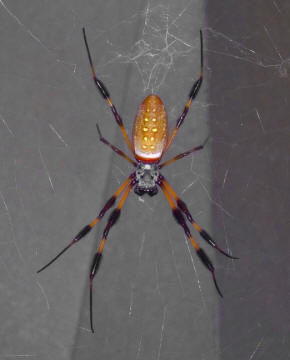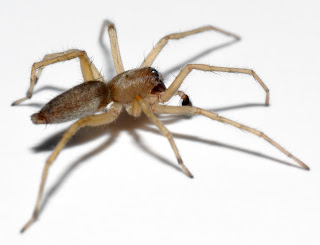I knew long ago that wood products were always good for the soil, long-term, but not if someone dumped a ton of fresh sawdust on the garden for mulch. That will soak up nitrogen for a time before releasing it into the soil again.
Somehow we got into a discussion where Mrs. I wanted to know about stumps being planted in the back yard. She knew I did that - but how and why? She laughed her head off while I was explaining in my serious - though wounded - gardening voice.
Cellulose (wood) is very complex in its chemical makeup, which is why fungi are designed by the Creator to break it down into chemical products useful at the plant's root level. As we all know, plain wooden boards left on the soil will rot. That is good for the soil but not always for the person who wanted to use the boards.
Also - earthworms love the environment created by logs left on the soil. Add toads and various insects, and a rustic fence or stumps in the ground are centers of influence for the natural world.
Bark holds a lot of insect life, semi-hidden as it goes through their life stages. However, bark is even tougher to break down. Fungi alone can do that.
"But why and how do you plant them?" More laughter.
 |
| The smiling saguaro cactus |
I explained - the stump I wanted, on the curbside, had arms like a saguaro cactus, but if I rested it on the ground, it would fall over. I had to dig a hole and plant it, to make it stable.
"But it will rot." Exactly - but very slowly.
A concrete block fence will attract birds, who rest there, but it will not clean itself. Reaching over the fence means gathering a lot of bird dung by accident. A wooden fence is a condo for creatures and self cleaning. We conquered the weedy undergrowth problem by inserting flattened carboard boxes under the entire fence.
Once we realize how keeping organic matter will benefit the lawn and garden, we covet more of the same, even our neighbor's who blow grass into the street and bag up leaves to be hauled away. I know the landscaper's brother will have me helping to get rid of their leaves this fall, and I will gladly coat the cardboard underlayer with leaves.
Brett Meyer reported that piling leaves under one tree doubled its production. I learned that had more effect that simply building up the soil by feeding all soil life. Beneficial insects over-winter in piles of leaves left along, and beetles gather there in the summer for night-time attacks on pests. Rove beetles and assassin beetles love leaf litter and zones of quiet where they do not fear the rototiller and rake.
 |
| And Simon answering said unto him, Master, we have toiled all the night, and have taken nothing: nevertheless at thy word I will let down the net. Luke 5:5 KJV |
Cursory Spiders - Who Knew?
I always loved to see spiders at work in the garden. Their webs show up decorated with rainbow diamonds in the morning dew. As soon as I put new mulch down, they let down their nets - "At your Word" - much like the disciples, counting on their Master for a good catch.
But there are valuable webless spiders, called cursory spiders, who go on the hunt for pests. They are free to roam while looking for food.
Spiders are very valuable to the farm and garden. They prey on insects and other spiders by trapping them in a web or pouncing on them. The former are known as web builders and the latter as cursorial spiders (also sometimes called wandering or hunting spiders). Prey are consumed in both groups after liquefaction with digestive enzymes. After breeding, females spin silken egg cases, each housing hundreds of eggs, and position them on webs or attach them to their abdomens. Some species die immediately after egg laying while many others care for the young spiderlings by protecting them on the web or toting them around on their backs.
Web-spinning spiders detect their prey through vibration and visual signals. Cursorial spiders use the same cues to spot and stalk potential prey. Cursorial spiders are of particular importance to gardeners and farmers as they are highly mobile and can travel to find prey, though some groups—the crab spiders, for example—spend nearly all their lives waiting in a single flower for unfortunate pollinators to come by so they can nab them and have them for dinner.
Numerous studies have proven again and again that spiders consume many herbivorous agricultural pests, including insect eggs, beetles, aphids, cutworms, fire ants, four-lined plant bugs, spider mites, squash bugs, budworms, caterpillars, and asparagus beetles. One study found that hunting spiders in some crops do at least a quarter of the total predation, much of it taking place at night.
It’s also been revealed that many cursorial spiders aren’t exclusively carnivorous. They also feed on nectar, and those that do so on a regular basis grow faster, survive longer, and reproduce more. They can detect the odor of nectar and can even learn to follow cues to obtain it. Fields offering large quantities of nectar have higher populations of spiders and often greater overall predation.
Walliser, Jessica (2014-02-26). Attracting Beneficial Bugs to Your Garden: A Natural Approach to Pest Control (Kindle Locations 1344-1353). Timber Press. Kindle Edition.
Until this summer I had no concept of armies of beetles and cursorial spiders roaming around to devour pests. I understood the result but not the environment needed. Composting and mulching - even in those ancient and innocent years - meant that I met the requirements for these good results. Now I am more confident in how God takes care of the pests for me.
In short, the modern concepts of gardening are antagonistic to the garden. Likewise, the modern church gimmicks are antagonistic to the Christian Faith, because both approaches lack faith in the Creator.
Tuesday, March 9, 2010
How to Raise a Spider Army
 Scientists at the USDA-ARS subtropical research station inWeslaco, TX are doing some really cool work developingspiders for biocontrol of ag pests.
Scientists at the USDA-ARS subtropical research station inWeslaco, TX are doing some really cool work developingspiders for biocontrol of ag pests.They're working with cursorial spiders, which spend their nights running around on plants and their days in improvised silk bivouacs.
These spiders are voracious predators of bug eggs and larvae and can really knock out pests when they reach decent population levels. The scientists found that spiders seemed more deadly on cotton than on maize or soybeans (relative to other predators, such as ants) - and hypothesized that this may be due to the presence of extrafloral nectaries on cotton.
To make a fascinating story short, these spiders drink nectar from flowers and extrafloral nectaries to supplement their buggy diet! They also probably eat yeast (which grows naturally in leaking plant sap and nectar). The availability of these "non-prey foods" allow these spiders to mature faster, live longer and produce more spiderlings when their insect prey is limited. Furthermore, they can respond to the smell of nectar and can even learn to associate novel scents with a sugary reward!
They specifically mentioned that they found spiders associated with coriander, buckwheat and alyssum flowers, but they probably can drink nectar from all kinds of plants. Next, they're gonna try spraying crops with a sugary or yeasty scented spider chow to see if they can attract and maintain populations to help control pests. It's definitely a long shot, as any ecologically-based biocontrol strategy has all the complications and limitations inherent in ecology, but I'll be excited to see what happens.
In the meantime, it's an example of the type of interactions that you hope to take advantage of by planting a diverse, mixed garden surrounded by native plants.
 |
| http://www.spiderzrule.com/commonspidersusa.htm |


